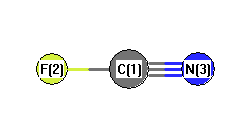Vibrational levels (cm-1) 
| Mode Number |
Symmetry |
Frequency |
Intensity |
Comment |
Description |
| Fundamental(cm-1) |
Harmonic(cm-1) |
Reference |
(km mol-1) |
unc. |
Reference |
| 1 |
Σ |
2317 |
|
Gurvich |
|
|
|
|
CN stretch |
| 2 |
Σ |
1060 |
|
Gurvich |
|
|
|
|
CF str |
| 3 |
Π |
451 |
|
Gurvich |
|
|
|
|
FCN bend |
vibrational zero-point energy: 2139.7 cm
-1 (from fundamental vibrations)
Calculated vibrational frequencies for
FCN (Cyanogen fluoride).
Geometric Data

Point Group C∞v
Internal coordinates
distances (r) in Å, angles (a) in degrees, dihedrals (d) in degrees
| Description |
Value |
unc. |
Connectivity |
Reference |
Comment |
| Atom 1 |
Atom 2 |
Atom 3 |
Atom 4 |
| rCF |
1.262 |
|
1 |
2 |
|
|
Gurvich |
|
| rCN |
1.159 |
|
1 |
3 |
|
|
Gurvich |
|
Cartesians
| Atom |
x (Å) |
y (Å) |
z (Å) |
| C1 |
0.0000 |
0.0000 |
0.0000 |
| F2 |
0.0000 |
0.0000 |
-1.2620 |
| N3 |
0.0000 |
0.0000 |
1.1590 |
Atom - Atom Distances 
Distances in Å
| |
C1 |
F2 |
N3 |
| C1 |
|
1.2620 | 1.1590 |
| F2 |
1.2620 |
|
2.4210 |
| N3 |
1.1590 | 2.4210 |
|
Calculated geometries
for FCN (Cyanogen fluoride).
Experimental Bond Angles (degrees) from cartesians 
| atom1 |
atom2 |
atom3 |
angle |
| F2 |
C1 |
N3 |
180.000 |
Bond descriptions
Examples: C-C single bond, C=C, double bond, C#C triple bond, C:C aromatic bond
| Bond Type |
Count |
| C-F |
1 |
| C#N |
1 |
Connectivity
| Atom 1 |
Atom 2 |
| C1 |
F2 |
| C1 |
N3 |
Dipole, Quadrupole and Polarizability
Electric dipole moment 
| State |
Config |
State description |
Conf description |
Exp. min. |
Dipole (Debye) |
Reference |
comment |
Point Group |
Components |
| x |
y |
z |
total |
dipole |
quadrupole |
| 1 |
1 |
1Σ |
C∞v |
True |
|
|
|
2.170 |
NSRDS-NBS10 |
MW μ0 |
C∞v |
1 |
1 |
Experimental dipole measurement abbreviations: MW microwave; DT Dielectric with Temperature variation; DR Indirect (usually an upper limit); MB Molecular beam
Calculated electric dipole moments for
FCN (Cyanogen fluoride).
Electric quadrupole moment 
| State |
Config |
State description |
Conf description |
Exp. min. |
Quadrupole (D Å) |
Reference |
comment |
Point Group |
Components |
| xx |
yy |
zz |
dipole |
quadrupole |
| 1 |
1 |
1Σ |
C∞v |
True |
|
|
|
|
|
C∞v |
1 |
1 |
Calculated electric quadrupole moments for
FCN (Cyanogen fluoride).
Electric dipole polarizability (Å3)  Calculated electric dipole polarizability
Calculated electric dipole polarizability for
FCN (Cyanogen fluoride).












